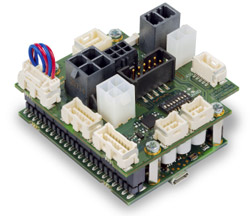
Posted to News on 4th Aug 2016, 09:45
Why a new generation of positioning controllers is needed
Biren Patel, the motion control engineering manager at maxon motor, discusses why industry needs a new generation of positioning controllers.

maxon motor has launched the EPOS4 next-generation positioning controllers, but why does industry need such a product?
The EPOS4 is a brushless DC motor controller with two different power ratings and connector board to allow quick integration into machinery. The position controllers are suitable for dynamic control of brushed and brushless DC motors with up to 750W continuous and 1500W peak power. A couple of things led us to develop the new Easy-to-use Positioning System (EPOS). We pride ourselves on staying up with technology and continually innovating. This is a position controller that is two-and-a-half times faster than our EPOS2 controllers. It is not going to replace those controllers, but complement them.
Engineers may have an application that does not need sophisticated position control, but something that is fast. This is where maxon motor's EPOS4 controller works "" to satisfy applications that need something in between high-end control and lower-end Digital Signal Processor (DSP)-based systems.
Over the years we have had customers ask us to make controllers more compact and with a higher power density. That is another thing that drove us to develop the EPOS4. The controller's pin headers are part of the main board, so are fixed; what is detachable is a compact board that goes on top of the main board for easy setup and quick builds of one-off applications.
Think about it: if an engineer is doing some feasibility analysis or proof-of-concept work, a traditional controller design would force that engineer to get in there and solder to the pins directly - and risk short-circuiting other pins or damaging the board itself. In contrast, our EPOS4 accepts a compact board that engineers can buy and then place on the EPOS4 - and then easily use the connectors there to connect different types of motors and power supplies and other motion components to complete feasibility tests.
Boost output just with heat sinks
In fact the modular design extends to other features on the controller as well. We have added an optional heat sink to boost controller-board capacity. We also recommend additional heat sinks to get higher current capacity at higher temperatures.
The base-model board without a heat sink outputs 8A. With the heat sink we can go to 15A continuous; add an additional heat sink and the controller can output 15A even in ambient environments exceeding 70-75degC, even under full load.
Both the EPOS2 and EPOS4 controllers have R232, USB and CANopen communication buses. The EPOS4 will include an option for EtherCAT communication as well. USB communication with the EPOS2 and EPOS4 is typically used for service and process interfacing. We have a high-end controller called the MAXPOS - for positioning - and that one only has EtherCAT connectivity.
In fact the controller is a true EtherCAT slave device and we see that as an important feature with everyone moving to the Ethernet. My personal opinion on this matter is that there is a big push toward EtherCAT because everyone wants to have the ability to mention EtherCAT connectivity in their marketing, even beyond the real-world benefits of the standard. That is another reason we gave the EPOS4 EtherCAT communication.
We offer EPOS Studio software (at no charge) so engineers can do more configuration and proof-of-concept feasibility analysis. We have a data recorder in the Studio software as well. It is easy to use and it includes a simple scope function. There are four channels that engineers can use to monitor things such as position and then see how the command compares to what the motor is actually doing.
Engineers can also use the software to monitor speed and current draw, and then check their work. For example, an engineer might design a linear motion system based on a lead screw, and then use EPOS Studio software to ensure it does not draw more than a given amount of current - or ensure that it is capable of outputting a given amount of torque.
EPOS Studio software can read all these values and compare them. It is very useful for configuring the drive - but, again, it can also do a lot more. Users can just input simple moves and record all the data related to the motion output to get a better idea of how their system is working.
Follow the link for more information about the new EPOS4 next-generation positioning controllers.






























